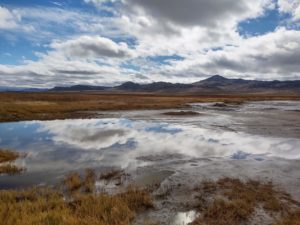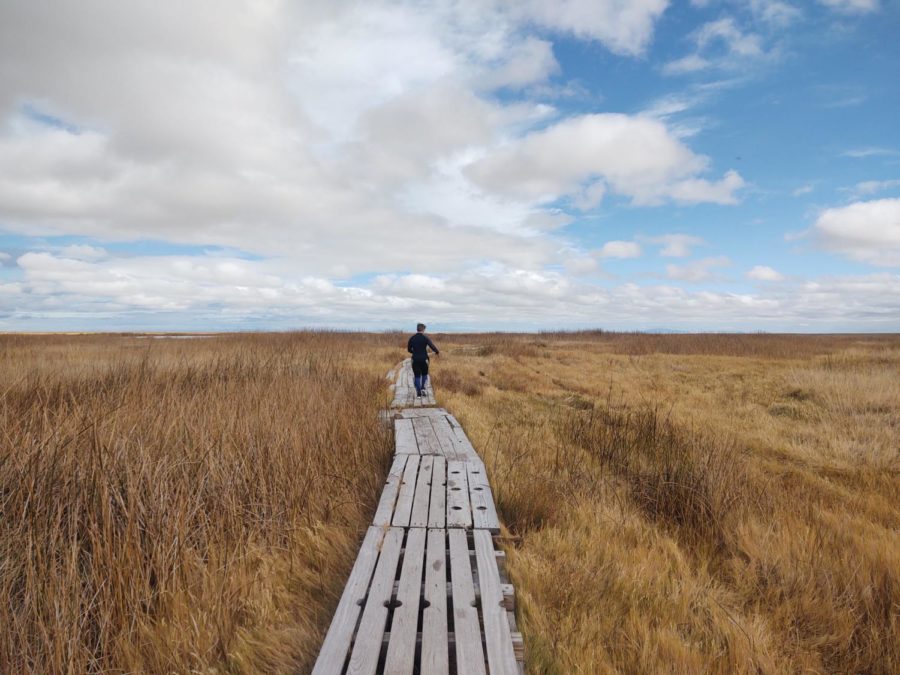Underwater Wasteland
It is the summer of 2021. I’m half asleep, nestled into the small bow of a speedboat with good friends, while the boat courses through water so turquoise, with corals underneath so bright and teeming with life, that we might as well be in an advertisement for a Caribbean resort. We are in the Caribbean, and my skin is stiff and flushed with salt and sunshine, muscles tired but relaxed from three dives through this almost unearthly water, and I feel the way these advertisements tell you that you will feel if you visit their beachside locales. I’ve lived alongside advertising long enough to know that reality almost always falls short, but this day is a day that surpasses even the wildest imaginations of a tourism marketing department. This — the sun, the ceviche, the luminous corals, the wetsuit hanging off my hips — is scuba diving.
It is six months later, January 2022. I’m at a pull-off on a long dirt road outside of Wendover on the Utah/Nevada state line. The air temperature, last time I checked, is 8˚F. As I scuttle down the rickety wooden platform from the rather deceptively named Blue Lake, I can feel the water in my thick wetsuit beginning to freeze. I discard my soaking shirt on the deck beside the car and by the time I pick it up just a few minutes later, it’s frozen into a crisp puck. For this early winter morning out in the lake, my reward has been a single small fish gazing at me through the greenish gloom, and ropes that guide me through water too murky to navigate otherwise to a sunken toilet, an upright rowboat, and a mannequin whose head jerks up and down when you pull on the rope like something out of a feverish nightmare. This time in the Great Basin, I am once again scuba diving.
Of the Great Basin, Mark Twain once said, “imagine a vast, waveless ocean stricken dead and turned to ashes.” In a similar spirit, the New York Times reported in 1925 that “in the opinion of those who have trailed the desert, the day will never come when any considerable part of it can be reclaimed.” Covering most of Nevada and extending roughly between Salt Lake City and Reno from east to west, and from southeastern Oregon to Las Vegas from north to south, the overwhelming perception of the Great Basin from at least the 19th century to the present can be summed up most succinctly as this: a wasteland. A region of little potential for settlement and traditional capitalist industry, and this lack paved the way for developments of a different flavor.
On June 14, 1945, the Enola Gay arrived at the Wendover Army Airfield, its last stop before departing for the Pacific to drop the first wartime atomic bomb on Hiroshima in August of that year. Six years later, the Nevada Test Site was developed on the southern edge of the Great Basin for a campaign of nuclear testing that lasted almost half a century, unleashing 1,000 nuclear explosions in the desert. At present, negotiations are underway to develop the first lithium mine in the United States, also in Nevada. Although widely celebrated in an increasingly urgent effort to reduce fossil fuel emissions, the increasing popularity of electric vehicles will, as a consequence, require a significant increase in lithium extraction to power batteries. Although lithium mining often takes place in arid regions, it requires tremendous water input and leaves behind radioactive and other toxic wastes known as tailings. Waste, though, belongs in a wasteland, so the reasoning goes.

As it concerns the Great Basin, the idea of wasteland is so entrenched that it scarcely requires explanation or justification. On the Wikipedia page for the Wendover Air Force Base, where the Enola Gay once parked, the author writes, “the airfield is very isolated in northwest Utah, sitting in the middle of a vast wasteland miles away from any major population center.” However, this relationship is not unidirectional. The Great Basin is not only the great testing ground because it falls under a conventional understanding of wasteland, but it also becomes a wasteland through the radiation risk, mine tailings, and military detritus that gather in its expansive bowl. In The Size of the Risk: Histories of Multiple Use in the Great Basin, Leslie Carr Childers writes, “by the turn of the twentieth century, the wasteland that was the Great Basin had become wasted land.”
Blue Lake outside of Wendover is usually quite serene. When the light hits it just right, the surface of the water reflects the clouds and the brownish hills in the distance glow golden. Nearby, an old sign warns divers and recreational fishermen to not wander beyond the posted limits due to the military testing nearby.
Shortly after I moved to Utah, I interviewed for a job at a local dive shop. “You moved here for the scuba diving, right?” My now-boss joked as we shook hands. It’s a joke that never gets old in the Utah dive community. While places like Blue Lake, like the Great Basin more broadly, might never make the front pages of diving magazines and brochures, it is precisely this obscurity, reflective of the Great Basin itself, that makes diving here fascinating. In the underwater parts of this so-called wasteland, we do not chase wildlife or light and color, but the excess, the surplus of our military projects and economic projects that leave behind things discarded and forgotten but many, many years yet from a return to soil. All the things that accumulate in wastelands, get tucked into distant corners of deserts and are sometimes sunk below pockets of water, natural or manmade, either way out of sight. A dive site in Lake Mead is an old B-29 Superfortress, once related to missile research, that crashed in 1948.
On Halloween, my dive shop hosted an event at Blue Lake that included an underwater zombie scavenger hunt. Participants, who had been infected with a “zombie virus,” followed directions on signs placed around the bottom of the lake to find the test tube “cure” that we’d tied to an old concrete block that we left behind when we were done. In the ocean, we rarely played games underwater because it paled in comparison to the wildlife around us. When we did, it was things like watching the colors fade in ROYGBIV order as we slipped further from the light of the sun, which penetrated deeply through the clear water. Here, a zombie apocalypse. It was Halloween-themed and a lot of fun, and also hard not to look at the surrounding landscape and think about the more literal zombie infections—the consequences of radiation carried on the breeze sometimes in the Great Basin and found its way into the cells of residents who, though sparse, existed and continue to exist across the region. In the end, the visibility of the lake was too bad that day for anyone to find the cure. Most probably swam right by it.
Like other recreative sports, scuba diving is often all glamor. Pristine coral reefs are to divers what a mountain range glowing with fall colors is to a hiker or biker, or what the twists and turns of a canyon are to a kayaker. Without these landscapes, though, people will always find ways to keep their favorite activity alive in spaces that hardly resemble ideal. Scuba diving here is not a watered-down version of what it can be in the tropics; rather, like most outdoor sports, it’s a window into the space that surrounds us, and a tool to access parts of that place that otherwise remain hidden. In the Great Basin, this reveals something of our history and conceptions of this high desert, from the vantage point of submersion in one of the many kinds of places that conceals the way wastelands are wasted.


